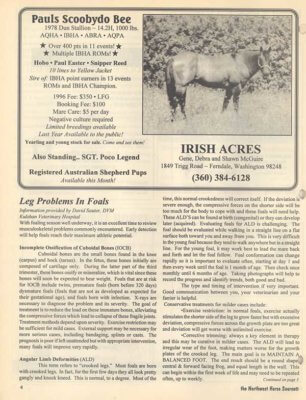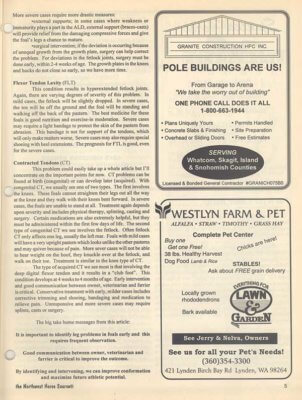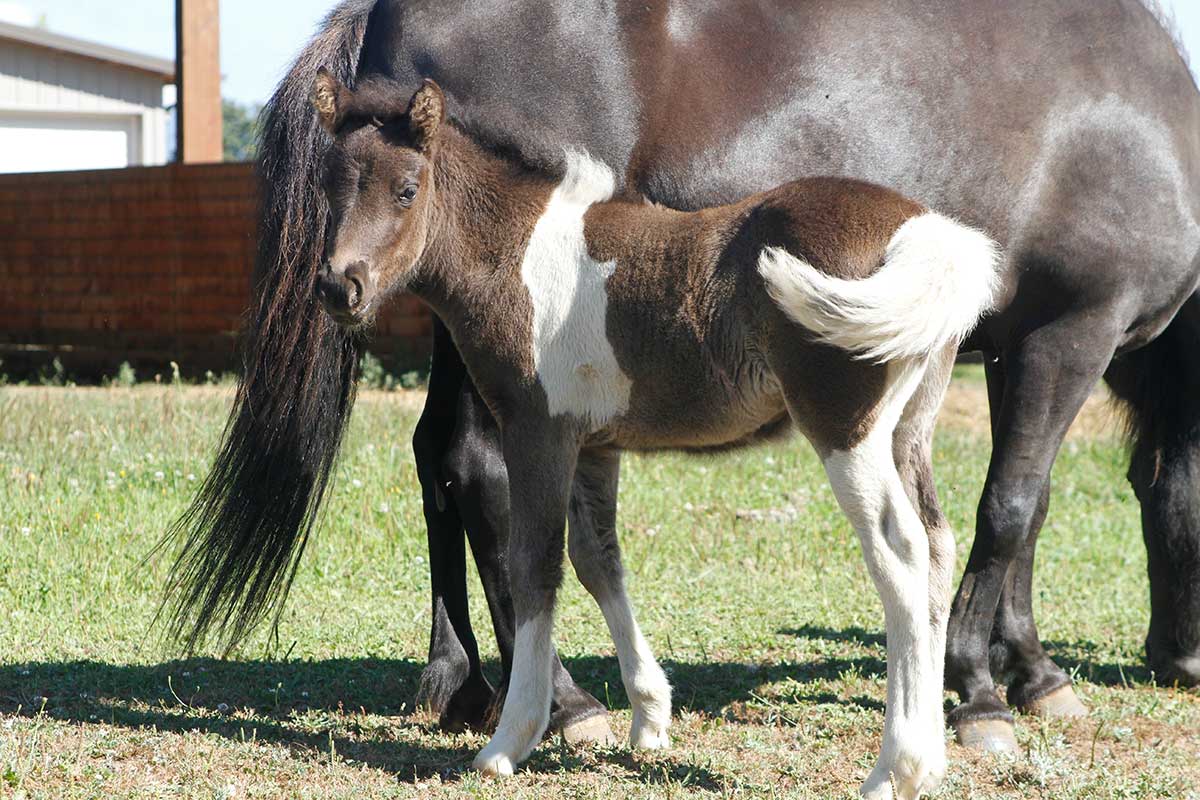With foaling season well underway, it is an excellent time to review musculoskeletal problems commonly encountered. Early detection will help foals reach their maximum athletic potential.
Incomplete Ossification of Cuboiclal Bones (IOCB)
Cuboidal bones are the small bones found in the knee (carpus) and hock (tarsus). In the fetus, these bones initially are composed of cartilage only. During the latter part of the third trimester, these bones ossify or mineralize which is vital since these bones will soon be expected to bear weight. Foals that are at risk for IOCB include twins, premature foals (born before 320 days) dysmature foals (foals that are not as developed as expected for their gestational age), and foals born with infection. X-rays are necessary to diagnose the problem and its severity. The goal of treatment is to reduce the load on these immature bones, alleviating the compressive forces which lead to collapse of these fragile joints. Treatment methods depend upon severity. Exercise restriction may be sufficient for mild cases. External support may be necessary for more serious cases, including bandaging, splints or casts. The prognosis is poor if left unattended but with appropriate intervention, many foals will improve very rapidly.
Angular Limb Deformities (ALO)
This term refers to “crooked legs.” Most foals are born with crooked legs. In fact, for the first few days they all look pretty gangly and knock kneed. This is normal, to a degree. Most of the time, this normal crookedness will correct itself. If the deviation is severe enough, the compressive forces on the shorter side will be too much for the body to cope with and these foals will need help. These ALD’S can be found at birth (congenital) or they can develop later (acquired). Evaluating foals for ALO is challenging. The
foal should be evaluated while walking in a straight line on a flat surface both toward you and away from you. This is very difficult in the young foal because they tend to walk anywhere but in a straight line. For the young foal, it may work best to lead the mare back and forth and let the foal follow. Foal conformation can change rapidly so it is important to evaluate often, starting at day 1 and then every week until the foal is I month of age. Then check once monthly until 6 months of age. Taking photographs will help to record the progress and identify trends, both good and bad.
The type and timing of intervention if very important. Good communication between you, your veterinarian and your farrier is helpful.
Conservative treatments for milder cases include:
- Exercise restriction: in normal foals, exercise actually stimulates the shorter side of the leg to grow faster but with excessive deviation, compressive forces across the growth plate are too great and deviation will get worse with unlimited exercise.
- Corrective trimming: always a key element in therapy and this may be curative in milder cases. The ALO will lead to irregular wear of the foot, making matters worse for the growth plates of the crooked leg. The main goal is to MAINTAIN BALANCED FOOT. The end result should be a round shape central & forward facing frog, and equal length in the wall. This can begin within the first week of life and may need to be repeated often, up to weekly.
More severe cases require more drastic measures:
- external supports; in some cases where weakness or immaturity plays a part in the ALD, external support (braces-casts) will provide relief from the damaging compressive forces and give the foal’s legs a chance to mature.
- surgical intervention; if the deviation is occurring because of unequal growth from the growth plate, surgery can help correct the problem. For deviations in the fetlock joints, surgery must be done early, within 2-4 weeks of age. The growth plates in the knees and hocks do not close so early, so we have more time.
Flexor Tendon Laxity (FLT)
This condition results in hyperextended fetlock joints. Again, there are varying degrees of severity of this problem. In mild cases, the fetlock will be slightly dropped. In severe cases, the toe will be off the ground and the foal will be standing and walking off the back of the pastern. The best medicine for these
foals is good nutrition and exercise-in moderation. Severe cases may require a light bandage to protect the skin of the pastern from abrasion. This bandage is not for support of the tendons, which will only make matters worse, Severe cases may also require special shoeing with heel extensions. The prognosis for FTL is good, even for the severe cases.
Contracted Tendons (CT)
This problem could easily take up a whole article but I’ll concentrate on the important points for now. CT problems can be found at birth (congenital) or can develop later (acquired). With congenital CT, we usually see one of two types. The first involves the knees. These foals cannot straighten their legs out all the way at the knee and they walk with their knees bent forward. In severe cases, the foals are unable to stand at all. Treatment again depends upon severity and includes physical therapy, splinting, casting and
surgery. Certain medications are also extremely helpful, but they must be administered within the first few days of life. The second type of congenital CT we see involves the fetlock. Often fetlock CT only affects one leg, usually the left rear. Foals with mild cases will have a very upright pastern which looks unlike the other pasterns and may quiver because of pain. More severe cases will not be able to bear weight on the hoof, they knuckle over at the fetlock, and walk on their toe. Treatment is similar to the knee type of CT.


The type of acquired CT we see most is that involving the deep digital flexor tendon and it results in a “club foot”. This condition develops at 4 weeks to 4 months of age. Early intervention and good communication between owner, veterinarian and farrier is critical. Conservative treatment with early, milder cases includes corrective trimming and shoeing, bandaging and medication to relieve pain. Unresponsive and more severe cases may require splints, casts or surgery.
The big take home messages from this article:
It is important to identify leg problems in foals early and this requires frequent observation.
Good communication between owner, veterinarian and farrier is critical to improve the outcome.
By identifying and intervening, we can improve conformation and maximize future athletic potential.
Printed in April 1996 Issue

Dave Sauter is a Minnesota native and graduated from the University of Minnesota in 1987. Following graduation he interned at Rood and Riddle Equine Hospital in Lexington, Kentucky. After this internship, he continued to work exclusively with horses for another five years in Kentucky before moving out West and joining Kulshan Veterinary Hospital in Lynden, WA. He is a member of the AAEP, AVMA and the WSVMA. For more information about Kulshan Veterinary Hospital call 360-354-5095 or email [email protected]. www.KulshanVet.com






